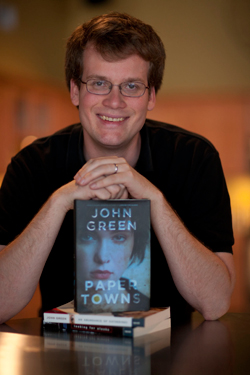Blogs, Vlogs, and E-books
By John Green '00

When I arrived at Kenyon in 1995, my home library seemed too immature to take with me, so I showed up in Gambier with exactly one book, Allen Ginsberg's small and short Howl and Other Poems. Of course, I soon learned that I'd brought a knife to a gunfight. I was surrounded by incoming freshmen with hundreds of books, and my single-volume library made me feel small and stupid. So with the help of my Bookstore account, I bought (and read) dozens of books my freshman year: Infinite Jest and On the Road and Generation X and Song of Solomon and many more, not to mention everything for school. (Okay. Not everything for school.) I don't know how I managed to do all that reading and still drink so much Miller Lite.
Except maybe this: That whole year, the only television I watched was about five minutes of the O.J. trial.
The best thing about all those books—I mean, aside from how brilliant they were and everything—was having them on my shelf. The single shelf above my desk was carefully calibrated to prompt discussion among visitors. Ideally, female visitors. With e-books, we lose this, which is tragic, indeed. But so far as I can tell, that's about all we lose.
We cannot afford to print our stories on thinly sliced trees forever. Nor can we afford the immense carbon footprint associated with the insane inefficiency of the contemporary book business. Every year, for instance, millions of books—which, as you will recall if you have ever moved, are heavy—get shipped from warehouses to bookstores, only to be shipped back to the warehouses a few months later. Thanks to this business practice, publishers destroy more than 250,000 tons of books each year.
Once we quit weeping over how good books smell, and fretting over what we'll do with our free time if we don't have two thousand books to dust each week, and whining that the Internet is making us dumb, we may even find that the Internet and electronic publishing will mean more readers reading more books.
I'm living proof of this, in fact. Once upon a time, I was an author of books for teenagers. My books were nicely reviewed and even won some awards, but they were never read by all that many people. Then I started blogging, and almost immediately, more people read my blog than my books. (The blog was free, after all.) Then, almost three years ago, my brother and I started making YouTube videos, which became improbably popular. (Improbably because we are … well, I don't want to say we are middle-aged, but we are certainly late early-aged, and we are nerds who make a lot of jokes about physics, which usually does not lead to popularity.)
So now I'm not just an author of books for teenagers. I'm a blogger and vlogger and (God help me) Twitter user who writes books for teenagers. Not only do my books reach more readers as a result of this career change, but so do other people's books. Late last year, for example, tens of thousands of our video viewers read The Catcher in the Rye with us and spent weeks discussing it in forums and chat rooms.
Our viewers live all around the world, and it's tough to get my books in some countries, so our American viewers have e-mailed PDFs of my books to readers from Iran to China. Can we really say that the book read on a screen in Tehran is inferior to the one read on paper in Gambier?
That said, I'm sure print publishing will be around for a while. Even though my books are read mostly by tech-savvy teenagers, Kindle and e-book sales made up less than .1 percent of my overall sales in 2008. But I have begun to switch over to screen reading, and I hope more of my readers do, too.
I'll mourn the printed book when it goes. But someday, a kid will show up at Kenyon with nothing but Howl in his Kindle—and I trust that his classmates will still shame him into filling it with stories that will enrich his life.

 Delicious
Delicious Facebook
Facebook StumbleUpon
StumbleUpon Digg
Digg reddit
reddit